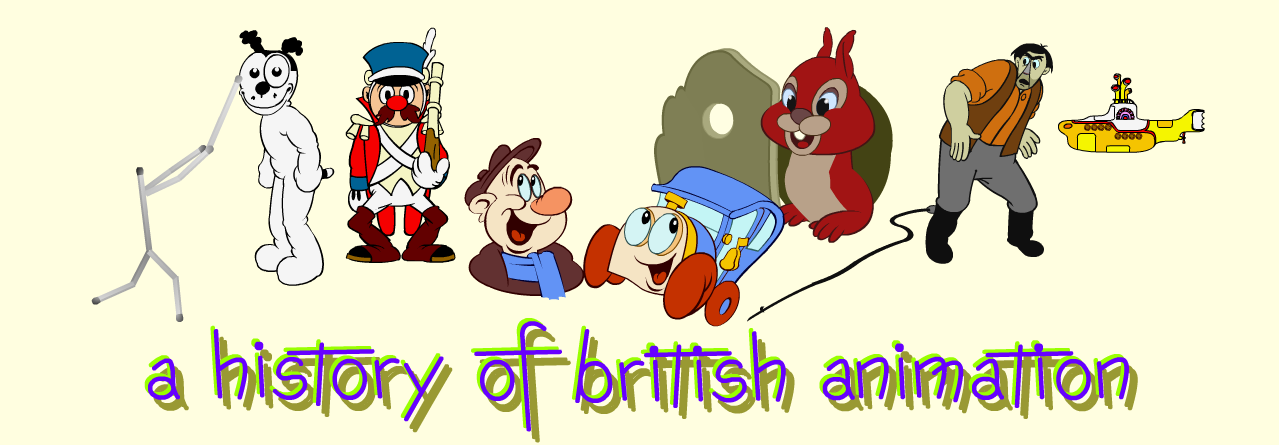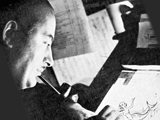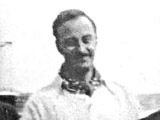

|
 | LAURIE PRICE(1902-1982) |  |
||
|
Laurence William Price was born 6 April 1902 in Fulham, London, son of William Thomas Price, a Post Office sorter, and his wife Emma. It seems he joined the Argyll & Sutherland Highlanders and was based at Parkhurst Barracks on the Isle of Wight. Here he met and courted Margarita Gulvin, and they married in 1924. Their first child, a daughter, was born in 1926. After leaving the Army and moving to London, Laurie was employed to provide artwork and animation by slide-maker Henry Luscombe Toms, who had diversified into advertising film production in 1922. In 1925 Luscombe Toms closed down the animation unit, offering to subcontract further work to the newly-formed Publicity Pictures in exchange for them employing Price. Initially the work at Publicity Pictures consisted mainly of animating cut-out lettering. Animation historian Ken Clark, who knew Laurie Price, writes: Laurie Price's notebook for the period commencing 1926 gives a clear picture of the traffic in 5—50 second local ‘flashes’ consisting of little more than animated type-matter. This low quality material cannot be found in existing records, nor does it deserve to be. However, even the longer ‘Solus’ productions are largely forgotten, and that is a pity. But both Price and Hopkins were keen to expand on the use of animation, and subcontracted work from other production companies. For Henry Luscombe Toms, Laurie Price designed and animated a little man called Orpheus to conduct the audience through the lyrics of a series of "sing-along" films, and also worked with the New Zealand cartoonist E F Hiscocks to animate a series of cartoons about cricket for release by Unity Films. According to Ken Clark, the studio facilities, and Price's expertise, were also put at the disposal of Australian artist Len Lye, enabling him to make his first animated film, Tusalava. Laurie, Margarita and their daughter moved into a house in Parkside Way, Harrow (a new development built on the old Headstone Manor estate) in 1928. They named the house "Gulvin" after Margarita's family. It remained the family home until Laurie's death in 1982. In 1929 Laurie left Publicity Pictures to join Super-Ads Ltd, a studio set up to provide a central animation service for other production companies. Here Laurie worked with other experienced animators in a stimulating atmosphere. However, the experiment was short-lived - Super-Ads closed down at the end of 1931, and Laurie returned to Publicity Pictures. Entertainment shorts were popular imports from the USA, but distributors in Britain were not prepared to pay enough to make them feasible here. As a result the advertising films aimed to fill the gap. The names under which Publicity Pictures produced its advertising films seem to show the influence and aspiration - Loony Libels for the black & white films, and later Cheery Chunes for the colour series. In Harrow the family expanded with a son born in 1935 and a second daughter born in 1937. In 1936 Publicity Films commissioned Publicity Pictures to provide animated sequences for Getting into Hot Water, a film for the Gas, Light & Coke Company. The animation consisted of around 175 ft (2 minutes) featuring the Gas Company's mascot Mr Therm. The character had been designed in 1931 by Eric Frazer, and was very familiar from press advertising. This was the first time Mr Therm had been animated. The voice was probably that of Maurice Denham, and I presume Laurie Price handled much of the animation. Some time around the end of 1937 Laurie Price left Publicity Pictures to work for Anson Dyer in Hammersmith. Dyer's companies had gone into voluntary liquidation, and his studio was now making advertising cartoons for Publicity Films, in space rented at Riverside Studios. Price remained with Anson Dyer after the outbreak of war in 1939, and probably worked on the series of propaganda cartoons featuring Hitler that the studio made for Gaumont-British Newsreels. In 1940 Anson Dyer and Bill Larkins formed Analysis Films Ltd to make information and propaganda films. According to Ken Clark, Price and a group of tracers & painters were then loaned to Technicolor Ltd, to provide the animated inserts for a series of Royal Navy training films. The intensity of the Blitz persuaded Anson Dyer to move his production unit and camera to Stroud, in Gloucestershire, and Laurie returned to Publicity Pictures. Here he started making models of tanks, planes and ships for stop-frame animation. This led to an interesting side line: according to Ken Clark, Price "designed a model kit for amateur construction of ‘The Santa Maria’, the first in a long series of such hobby-kits." Reg Hill, who worked at National Interest Picture Productions in the late 40s/early 50s, is credited as working on a series of cut-ouit 3D paper models (flat printed sheets of parts that were cut out, folded and glued together) at this time, so it may be that he and Laurie collaborated on this project. After the War, Clark relates, Price was loaned to GB Instructional "to make an official diagrammatic record of the invasion plans and a second film depicting the after-effects of the atom bomb (models)". I have not been able to determine which films these were, so they are not included in the filmography below. It may be that Price was working for GB Instructional on behalf of Analysis Films : certainly he was working with Anson Dyer's animators in 1946 on Squirrel War, a three-part serial cartoon for GB Instructional, which was also the production company for Rank's Children's Entertainment Division. This was followed by another children's cartoon, Who Robbed the Robins? in 1947, and the first two films in the Adventures of Soupy series of advertising films for for Symington's Soups, produced by Anson Dyer's newly-formed company Stratford Abbey Films in 1948. Laurie Price's name is missing from the list of animators that Gifford gives for the third and fourth Soupy films, so it would seem that by 1949 he had returned to National Interest Picture Productions. Certainly he was working there in September 1955, when, as Ken Clark relates, he saw a photo of Carl Giles with some nurses in the Daily Express. Price showed the picture to Chris Millett, saying it was the office junior, Ronnie Giles, from their days at Super-Ads. Millett thought Giles looked too fat to have been little Ronnie, so Price wrote to Giles for confirmation and was delighted to receive a genial reply accompanied by a cartoon of a young Giles rolling down stairs in a film bin, a reference to past pranks plyed by the animators. In 1954 Laurie's elder daughter had married and left home. After a couple of years in rented flats in London, she and her husband, also raised in North Harrow, moved into a house in Parkside Way, across the road from her parents. The same year, 1957, the younger daughter also married. She and her husband set up home in Amersham. However, in 1963 they too returned to Harrow, taking the house nextdoor to Laurie and Margarita. It may be that Margarita was in poor health: she died in March 1967. I don't know exactly when Laurie Price retired - it might have been in the mid 1960s, when Albert Hopkins withdrew from National Interest Picture Productions. He died in 1982 at the age of 80. |
Filmography | ||||
| The Language of Cricket No. 1 | (Publicity Pictures for Luscombe, 1926) Animator | |||
| The Language of Cricket No. 2 | (Publicity Pictures for Luscombe, 1926) Animator | |||
| The Language of Cricket [No. 3?] | (Publicity Pictures for Luscombe, 1926) Animator | |||
| Am I Wasting My Time on You? (Community Song series) | (Publicity Pictures for Luscombe, 1927) Animator, Director | |||
| Bye Bye Blackbird (Community Song series) | (Publicity Pictures for Luscombe, 1927) Animator, Director | |||
| The Frothblowers' Anthem (The More We Are Together) (Community Song series) | (Publicity Pictures for Luscombe, 1927) Animator, Director | |||
| It Made Me Happy When You Made Me Cry (Community Song series) | (Publicity Pictures for Luscombe, 1927) Animator, Director | |||
| Let Me Call you sweetheart (Community Song series) | (Publicity Pictures for Luscombe, 1927) Animator, Director | |||
| Perhaps You'll Think of Me (Community Song series) | (Publicity Pictures for Luscombe, 1927) Animator, Director | |||
| Shepherd of the Hills (Community Song series) | (Publicity Pictures for Luscombe, 1927) Animator, Director | |||
| To-night You Belong to Me (Community Song series) | (Publicity Pictures for Luscombe, 1927) Animator, Director | |||
| The Little White House (Community Song series) | (Publicity Pictures for Luscombe, 1927) Animator, Director | |||
| Kentucky Lullaby ((Community Song series) | (Publicity Pictures for Luscombe, 1927) Animator, Director | |||
| At the End of Honeymoon Lane (Community Song series) | (Publicity Pictures for Luscombe, 1927) Animator, Director | |||
| I Can't Forget (Community Song series) | (Publicity Pictures for Luscombe, 1927) Animator, Director | |||
| Loony Libels (advertising films, titles unknown) | (Publicity Pictures, 1933?) Directing Animator | |||
| Morris May Day | (A Cheery Chune, Publicity Pictures, 1935) Directing Animator | |||
| The Midshipman | (A Cheery Chune, Publicity Pictures, 1935) Directing Animator | |||
| The Baronial Beanfeast | (A Cheery Chune, Publicity Pictures, 1935) Directing Animator | |||
| Carnival Capers | (A Cheery Chune, Publicity Pictures, 1935) Directing Animator | |||
| The Gay Cavalier | (A Cheery Chune, Publicity Pictures, 1935) Directing Animator | |||
| Getting into Hot Water (animated scenes) | (Publicity Pictures for Publicity Films, 1936) Animator | |||
| The King with the Terrible Hiccups | (Anson Dyer, 1937) Animator | |||
| This Button Business | (Anson Dyer, 1938) Animator | |||
| Red, White and Blue | (Anson Dyer, 1938) Animator | |||
| You're Telling Me | (G-B Screen Services, 1939) Animator | |||
| Blowing Bubbles | (Anson Dyer, 1940) Animator | |||
| Eye Shooting | (Analysis Films/Technicolor Ltd, 1942) Storyboard, Animator | |||
| Wind | (Analysis Films/Technicolor Ltd, 1942) Storyboard, Animator | |||
| Approach Angle | (Analysis Films/Technicolor Ltd, 1942) Storyboard, Animator | |||
| 'X' Marks the Spot: Map Symbols Explained | (Publicity Picture Productions, 1942) Diagram Animator | |||
| Fire Direction - Close Defence | (Publicity Picture Productions, 1942) Diagram Animator | |||
| Handling & Laying British Anti-tank Mines | (Publicity Picture Productions, 1942) Diagram Animator | |||
| Infantry Role in Clearing Minefields by Hand | (Publicity Picture Productions, 1942) Producer, Director | |||
| U-Boat Attacks on Convoys No. 1 | (Publicity Picture Productions, 1942) Model Animator | |||
| U-Boat Attacks on Convoys No. 2 | (Publicity Picture Productions, 1942) Model Animator | |||
| U-Boat Attacks on Convoys No. 3 | (Publicity Picture Productions, 1942) Model Animator | |||
| Where's That Milk? | (Publicity Picture Productions, 1943) Diagram Animator | |||
| Attack on U-Boat No. 1 | (Publicity Picture Productions, 1943) Model Animator | |||
| 17 PDR Anti-tank Gun: Sights, Sight Testing and Zeroing | (Publicity Picture Productions, 1943) Diagram Animator | |||
| Handling & Maintenance of the LL Cable | (Publicity Picture Productions, 1943) Diagram Animator | |||
| Radio Location Part VIII | (Publicity Picture Productions, 1944) Diagram Animator | |||
| Mechanics of Recovery | (Publicity Picture Productions, 1944) Diagram Animator | |||
| Air Photo Reading in the Field III: How to Use Air Photographs | (Publicity Picture Productions, 1944) Diagram Animator | |||
| Bren 303 LMG Mechanism | (Publicity Picture Productions, 1945) Diagram Animator | |||
| Pistol Revolver No. 2 Mechanism | (Publicity Picture Productions, 1945) Diagram Animator | |||
| The Military Map and Conventional Signs (Map Reading I) | (Publicity Picture Productions, 1945) Diagram Animator | |||
| Contours, Hills and Slopes (Map Reading II) | (Publicity Picture Productions, 1945) Diagram Animator | |||
| Contours, Spurs, Re-entrants and Valleys (Map Reading III) | (Publicity Picture Productions, 1945) Diagram Animator | |||
| Visibility (Map Reading IV) | (Publicity Picture Productions, 1946) Diagram Animator | |||
| Map Setting and Position Finding (Map Reading V) | (Publicity Picture Productions, 1946) Diagram Animator | |||
| Comparison of Map and Ground (Map Reading VI) | (Publicity Picture Productions, 1945) Diagram Animator | |||
| Aids to Direction (Map Reading VII) | (Publicity Picture Productions, 1946) Diagram Animator | |||
| Measurement of Distance and Choosin Route (Map Reading VIII) | (Publicity Picture Productions, 1946) Diagram Animator | |||
| Direction on the Map (Map Reading IX) | (Publicity Picture Productions, 1946) Diagram Animator | |||
| Direction on the Ground (Map Reading X) | (Publicity Picture Productions, 1946) Diagram Animator | |||
| Use of Prismatic Compass (Map Reading XI) | (Publicity Picture Productions, 1946) Diagram Animator | |||
| Squirrel War: part 1 The Doll's House | (Analysis Films for GB Instructional, 1947) Animator | |||
| Squirrel War: part 2 The Storm | (Analysis Films for GB Instructional, 1947) Animator | |||
| Squirrel War: part 3 Springtime | (Analysis Films for GB Instructional, 1947) Animator | |||
| Who Robbed the Robins? | (Analysis Films for GB Instructional, 1947) Animator | |||
| Timber! (The Adventures of Soupy #1) | (Stratford Abbey Films for Publicity Films, 1948) Animator | |||
| Jump to It (The Adventures of Soupy #2) | (Stratford Abbey Films for Publicity Films, 1948) Animator | |||
Links to Other Sites | ||||
Peter Hale
Last updated 2017
|